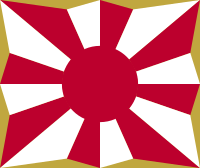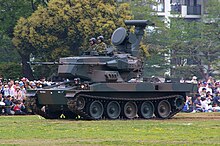Ground Self-Defense Forces
|
Ground Self Defense Forces |
|
|---|---|
 Flag of the Ground Self Defense Forces |
|
| Lineup | 1954 |
| Country |
|
| Armed forces | Self Defense Forces |
| Type | Land Forces |
The ground self-defense forces ( Japanese 陸上 自衛隊 , Rikujō Jieitai , English Japan Ground Self-Defense Force , abbreviated JGSDF) are the de facto army of Japan . They currently have almost 148,300 soldiers and are numerically the largest part of the self-defense armed forces .
history
On August 15, 1945, Japan accepted the Potsdam Declaration , which among other things provided for the complete disarmament of the Japanese army. As a result, the Imperial Japanese Army and the Imperial Japanese Navy were disbanded. With the beginning of the occupation in Japan , the occupation forces took over responsibility for the external defense of Japan.
The San Francisco Peace Treaty came into effect on April 28, 1952 and made Japan an independent country again. The National Security Council began its work that same year. He initially monitored the reserve forces of the police, the coast guard and the minesweeping units.
In 1954, the newly created Office for Defense restructured the National Security Council and formed the self-defense forces with the units of ground self-defense forces, air self- defense forces and sea self- defense forces . The word army was deliberately avoided as Article 9 of its constitution prohibits Japan from raising an army. The head of the Office of Defense did not have the rank of minister.
The ground self-defense forces had their first foreign deployment in 2004 to the American-led occupation of Iraq , where they were involved in reconstruction measures.
Starting in 2005, the Office for Defense was reorganized and only raised to the rank of ministry in January 2007 .
assignment
Due to the provisions of the Japanese constitution , which only provides for military action in the legal interpretation, the army, as well as the country's navy and air forces , is very defensive. The Army therefore sees its main task as repelling enemy landing operations. Although the topography favors the defender, it is difficult to defend the entire coastline and all four main islands of the country at the same time. Therefore, Japanese military doctrine explicitly provides for support from the United States' armed forces .
As part of the restructuring of the armed forces in Japan agreed on October 29, 2005 between the Japanese and US governments, the command of the ground self-defense forces is to deal more intensively with the defense against terrorism , guerrilla attacks and other crises. As a result of this, on March 28, 2007, the Central Readiness Force was put into service, which includes suitable specialist associations for special operations at home and abroad.
Troop strength
As in Germany, Japanese politics quickly saw the need for a standing army . In order not to undermine the leeway that the current constitutional interpretation offered with regard to self-defense, the number of troops was limited and defense policy was coordinated with that of the USA. Originally the JGSDF were 75,000 strong, in 1952 there were 110,000. Two years later the army had another 20,000 more men. By the end of the Cold War , the political limit reached 180,000 men. However, the defense authority, which only became a ministry in 2007 , never exhausted this because there was not enough equipment for so many soldiers . Since the end of the Cold War, the strength of the ground self-defense forces has leveled off at just under 150,000, so that modernization could be initiated.
organization
Tactical organization
The JGSDF consists of a tank division and nine infantry divisions as well as four infantry brigades, one airborne brigade , two mixed brigades , three training brigades , one artillery brigade and two anti-aircraft brigades . There is also a helicopter brigade made up of 24 squadrons and two swarms that are equipped with anti-tank helicopters .
Territorial organization
The Japanese army is also divided up territorially in order to be able to offer at least a rudimentary protection. There are a total of five major associations :
- Northern Army ( headquarters in Chūō-ku , Sapporo in Hokkaidō Prefecture ) for the Hokkaidō region . It is the only territorial group with three divisions , as Japan long feared an invasion of the Soviet Army here :
- 2nd division
- 5th Brigade
- 7th Armored Division
- 11th Division (to be restructured into a brigade)
- 1st artillery brigade
- 1st anti-aircraft artillery brigade
- 3rd Engineer Brigade
- various support units
- Northeast Army (headquarters in Miyagino-ku , Sendai , Miyagi Prefecture ) for the Tōhoku region :
- 6th division
- 9th division
- 2nd Engineer Brigade
- mixed brigade of the Northeast Army
- various support units
- Eastern Army (headquarters in Nerima , Tokyo Prefecture ) for the Greater Kantō region ( Kantō and Kōshinetsu ):
- 1st division
- 12th Brigade
- 1st Engineer Brigade
- 1st training brigade
- various support units
-
Central Army (headquarters in Itami , Hyōgo prefecture ) for the regions of Kinki , Tōkai , Hokuriku , Chūgoku and Shikoku :
- 3rd division
- 10th division
- 13th Brigade
- 14th brigade
- 4th Engineer Brigade
- 2nd training brigade
- various support units
- Western Army (headquarters in Kumamoto , Kumamoto Prefecture ) for the Kyūshū and Okinawa regions :
- 4th division
- 8th division
- 1st mixed brigade
- 2nd anti-aircraft artillery brigade
- 5th Engineer Brigade
- 3rd training brigade
- various support units
Special units and support units with a central function for all large territorial units report directly to the Defense Minister:
- central on-call staff
- 1st Airborne Brigade
- Amphibious Rapid Response Brigade
- Special task force
- 1st helicopter brigade
- 101. Special anti-weapon unit
- Training unit for international assignments
- Telecommunications Brigade
- central communication unit
- military police
- central finance command
- central transport command
- central service support command
- central weather service
- central financial auditing service
- Musical unit
- Message blocking unit
equipment
Main battle tank


Armored personnel carriers
- Type 89 (70)
artillery
- Type 75 (140), 155 mm self-propelled howitzer
- M110 (90), howitzer
- MLRS (90), multiple rocket launcher
- Type 99 , 155 mm self-propelled howitzer
Field howitzer
- FH-70 (480)
mortar
- M2 4.2 inch mortar (107 mm)
- Type 64 (81 mm)
- L16 (81 mm)
- Thomson-Brandt 120 mm mortar
- Type 96 (120 mm)
Armored vehicles
- Type 82 Command and Communication Vehicle (500)
- Type 87 Reconnaissance and Warning Vehicle
- Komatsu LAV (1,300+)
Armored transport
- Type 60 APC (60)
- Mitsubishi Type 73 (340)
- Type 96 (160)
Anti-aircraft tank
- Type 87 (41)
FLAK
Anti-tank guided missiles / anti-ship missiles
- Type 01 LMAT
- Type 64 MAT
- Type 79 Jyu-MAT
- Type 87 Chu-MAT
- Type 88
- Type 96 Multi-Purpose Missile System
Anti-aircraft missiles
- Improved HAWK
- FIM-92 Stinger (80)
- Type 81 Tan-SAM (57)
- Type 91 Hand Arrow (210)
- Type 93 Closed Arrow (90)
- Type 03 Medium-Range Surface-to-Air Missile
- MIM-104 Patriot variant PAC-3
Others
- Hitachi Type 73
- Mitsubishi Type 73 Light Truck
- Toyota Type 73 Medium Truck
- Isuzu Type 73 Heavy Truck
- Toyota High Mobility Vehicle
Handguns

- Howa type 89
- Howa type 64
- Minebea PM-9
- Sumitomo MINIMI
- Sumitomo M2
- Howa type 96
- M4 (selected units only)
- M16 (selected units only)
- Sumitomo NTK-62
- SCK / Minebea 9mm pistol
- M24
- Howa 84RR
- Nissan / IHI Aerospace 110mm LAM
- M203
Aircraft
As of the end of 2013
| Aircraft | origin | use | version | active | Ordered | Remarks | |
|---|---|---|---|---|---|---|---|
| Planes | |||||||
| Beechcraft King Air |
|
Reconnaissance plane | King Air 350 | 7th | |||
| Mitsubishi MU-2 |
|
Transport plane | 4th | ||||
| helicopter | |||||||
| Bell AH-1 Cobra |
|
Attack helicopter | AH-1S | 75 | Produced under license by Fuji | ||
| Hughes AH-64 Apache |
|
Attack helicopter | AH-64D | 10 | Produced under license by Fuji | ||
| Hughes OH-6 Cayuse |
|
Light reconnaissance and attack helicopter | OH-6D | 106 | Target by Kawasaki OH-1 to be replaced | ||
| Kawasaki OH-1 ninja |
|
Reconnaissance helicopter | 37 | 1 | another 112 in planning | ||
| Boeing-Vertol CH-47 Chinook |
|
Medium-weight transport helicopter | CH-47J CH-47JA |
58 | Produced under license by Kawasaki | ||
| Sikorsky UH-60 Black Hawk |
|
Transport helicopter | UH-60JA | 34 | Produced under license by Mitsubishi | ||
| Bell UH-1 Iroquois |
|
Transport helicopter | UH-1H UH-1J |
153 | |||
| Enstrom 480 |
|
Training helicopter | 12 | 8th | |||
swell
Web links
- Official website of the Ground Self-Defense Forces (English) (Japanese)
- The ground Self-Defense Forces at GlobalSecurity.org (Engl.)
- Equipment of the Japanese Army at GlobalSecurity.org (Eng.)
- Department of Defense datasheet on the number and specifications of military equipment . Archived from the original on July2, 2009; accessed on March 23, 2020.
Individual evidence
- ^ Source: Authorized and Actual Numbers of Self-Defense Personnel . Japanese Ministry of Defense data sheet ( July 6, 2007 memento on the Internet Archive ). As of March 31, 2006. Accessed June 27, 2007.
- ↑ World Air Forces 2014. (PDF; 3.9 MB) In: Flightglobal Insight. 2014, archived from the original on December 25, 2013 ; accessed on March 26, 2014 (English).






